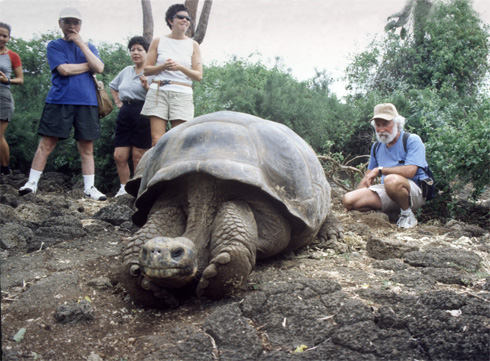Last week, Lonesome George, considered the rarest creature on Earth because he was the last member of his species, died. George was a giant tortoise of a species found only on Pinta Island in the Galápagos. For the last forty years he has been living on Santa Cruz Island at the Darwin Research center. He was estimated to be around 100 years old, young for a Galápagos tortoise which sometimes live past the age of 200. Over the years attempts were made to breed him with females of closely related species but he never found a lady tortoise that interested him.

The Galápagos Islands, home to the giant tortoises and many other unique species were first discovered in 1535 by Tomas de Berlanga, the bishop of Panama, when his ship drifted off course while on its way to Peru. He named the Islands Las Encantadas, “The Enchanted,” and marveled at the thousands of giant tortoises living there. Because of these tortoises, the Islands became known as the Galápagos—the Spanish word for tortoise.
Sailors—explorers, pirates and whalers, saw the huge tortoises, which weigh up to 550 pounds, as a convenient source of fresh meat, for the tortoises can survive long periods of time without food or water, and can live in the hold of a ship for up to a year. When British naturalist Charles Darwin visited the Galápagos in 1835, aboard the HMS Beagle, the islands’ residents showed him how to tell which island a tortoise belonged to by the shape of its shell. Pondering the causes for this localized diversity led Darwin to develop his Theory of Evolution.
At the time of his visit there were around a quarter of a million tortoises living on the islands. Today less than 15,000 remain. Of the original 15 subspecies, only eleven are left—three have become extinct and the fourth has only one individual left. Thousands of the animals were slaughtered by the crews of sailing ships and, when the islands were colonized in 1832, pigs, goats, rats and other animals also arrived, eating eggs and young tortoises and destroying nests and food supplies.
It is believed that the tortoises, who can float on the sea for several days, came to the Galapagos from the South American mainland. Once on the islands they encountered no enemies. Each of the islands presented its own unique environmental challenges, and the isolated tortoises evolved to take advantage of these differences—tortoises on islands with taller vegetation have longer necks.
Because of the tortoises extreme longevity, visitors to the Islands may unknowingly photograph some of the same tortoises that Darwin himself observed back in 1835.
